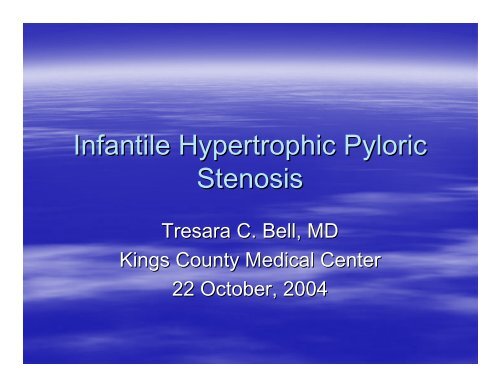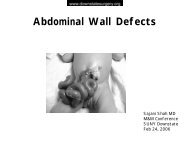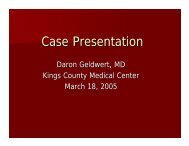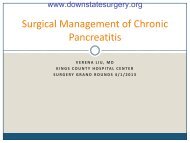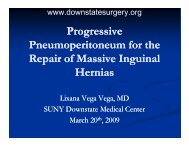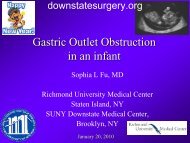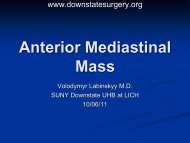Infantile Hypertrophic Pyloric Stenosis - Department of Surgery at ...
Infantile Hypertrophic Pyloric Stenosis - Department of Surgery at ...
Infantile Hypertrophic Pyloric Stenosis - Department of Surgery at ...
You also want an ePaper? Increase the reach of your titles
YUMPU automatically turns print PDFs into web optimized ePapers that Google loves.
<strong>Infantile</strong> <strong>Hypertrophic</strong> <strong>Pyloric</strong><br />
<strong>Stenosis</strong><br />
Tresara C. Bell, MD<br />
Kings County Medical Center<br />
22 October, 2004
<strong>Pyloric</strong> <strong>Stenosis</strong><br />
• <strong>Infantile</strong> hypertrophic pyloric stenosis (IHPS) is a<br />
condition th<strong>at</strong> effects young infants.<br />
• The pylorus becomes abnormally thickened and<br />
manifests as obstruction to gastric emptying.<br />
• Infants with IHPS are clinically normal <strong>at</strong> birth, and<br />
subsequently develop nonbilious forceful<br />
(“projectile”)) vomiting during the first few weeks <strong>of</strong><br />
postn<strong>at</strong>al life.<br />
• Gastric outlet obstruction leads to emaci<strong>at</strong>ion and,<br />
if left untre<strong>at</strong>ed, may result in de<strong>at</strong>h
Historical Perspective<br />
• Despite its frequency, it was virtually unknown<br />
prior to 1627, when a clinical description with<br />
survival was described by Fabricious Hildanus.<br />
• Over the next 2 centuries, only 7 additional cases<br />
were described, some without p<strong>at</strong>hologic pro<strong>of</strong><br />
and <strong>of</strong> doubtful origin.<br />
• Harald Hirschsprung presented 2 infant girls with<br />
p<strong>at</strong>hologically proved IHPS <strong>at</strong> the German<br />
Pedi<strong>at</strong>ric Congress in 1887.<br />
• A pr<strong>of</strong>usion <strong>of</strong> scientific interest was triggered, and<br />
by 1910, 598 cases had been recognized. Even as<br />
l<strong>at</strong>e as 1905, its existence was still occasionally<br />
doubted.
Epidemiology<br />
• The incidence <strong>of</strong> IHPS is approxim<strong>at</strong>ely 2 to 5 per<br />
1,000 births per year in most white popul<strong>at</strong>ions.<br />
• Less common in India, and among black and<br />
Asian popul<strong>at</strong>ions, with a frequency th<strong>at</strong> is one-<br />
third to one-fifth th<strong>at</strong> in the white popul<strong>at</strong>ion.<br />
• The male-to<br />
to-female r<strong>at</strong>io is approxim<strong>at</strong>ely 4:1.<br />
• There is a famlilial link, but a hereditary<br />
propensity to the development <strong>of</strong> IHPS is likely<br />
polygenic with no single locus accounting for the<br />
fivefold increase in the risk <strong>of</strong> first-degree<br />
rel<strong>at</strong>ives.
Epidemiology<br />
• Male and female children <strong>of</strong> affected f<strong>at</strong>hers carry<br />
a risk <strong>of</strong> 5% and 2% respectively, <strong>of</strong> developing<br />
IHPS.<br />
• Male and female children <strong>of</strong> affected mothers<br />
carry a risk <strong>of</strong> 20% and 7%, respectively <strong>of</strong><br />
developing IHPS.<br />
• Concordance in monozygotic twins is 0.25-0.44,<br />
0.44,<br />
and th<strong>at</strong> in dizygotic twins is 0.05-0.10.<br />
0.10.
IHPS An<strong>at</strong>omy<br />
• In IHPS the pyloric ring is no longer<br />
a clearly defined separ<strong>at</strong>ion<br />
between the pyloric canal and<br />
duodenum.<br />
• Instead the muscle <strong>of</strong> the pyloric<br />
antrum is hypertrophic (3 or more<br />
mm), which separ<strong>at</strong>es the normal<br />
antrum (1mm thickness) from the<br />
duodenum.<br />
• The lumen is filled with compressed<br />
and redundant mucosa, which<br />
obstructs the passage <strong>of</strong> gastric<br />
contents.
IHPS An<strong>at</strong>omy
Clinical Present<strong>at</strong>ion<br />
• Varies with length <strong>of</strong> symptoms.<br />
• Recent onset <strong>of</strong> forceful nonbilious vomiting,<br />
typically described as “projectile. projectile.”<br />
• Frequency <strong>of</strong> vomiting is initially intermittent, but<br />
will progress to follow all feedings.<br />
• Emesis may become blood tinged with protracted<br />
vomiting, likely rel<strong>at</strong>ed to gastritis.<br />
• Since the child is unable to achieve adequ<strong>at</strong>e<br />
nutrition, he or she exhibits a voracious appetite.
Clinical Present<strong>at</strong>ion<br />
• Starv<strong>at</strong>ion can exacerb<strong>at</strong>e diminished hep<strong>at</strong>ic<br />
glucoronyl transferase activity, and indirect<br />
hyperbilirubinemia may be seen in 1-2% 1<br />
<strong>of</strong><br />
affected infants.<br />
• Prolonged vomiting leads to the loss <strong>of</strong> large<br />
quantities <strong>of</strong> gastric secretions rich in H + and Cl - .<br />
• As a result <strong>of</strong> dehydr<strong>at</strong>ion, the kidney <strong>at</strong>tempts to<br />
conserve Na + to maintain volume, by exchanging<br />
them for K + and H + (paradoxical aciduria).<br />
• The net result is a loss <strong>of</strong> H + and K + , which results<br />
in hypokalemic, hypochloremic metabolic acidosis.
Etiology<br />
• It has been found th<strong>at</strong>, when compared to<br />
controls, in IHPS specimens, the muscle layer is<br />
deficient in:<br />
– the quantity <strong>of</strong> nerve terminals<br />
– markers for nerve-supporting cells<br />
– peptide-containing nerve fibers<br />
– nitric oxide synthase activity<br />
– mRNA production for nitric oxide synthase<br />
– Interstitial cells <strong>of</strong> Cajal<br />
Ohshiro and Puri. . P<strong>at</strong>hogenesis <strong>of</strong> infantile hypertrophic pyloric<br />
stenosis: : recent progress. Pedi<strong>at</strong>r Surg Int (1998)13:243-252.<br />
252.
Etiology<br />
• IHPS specimens contain increases in:<br />
– Insulin-like like growth factor<br />
– pl<strong>at</strong>elet-derived growth factor<br />
• It is postul<strong>at</strong>ed th<strong>at</strong> this abnormal innerv<strong>at</strong>ion <strong>of</strong><br />
the muscular layer leads to failure <strong>of</strong> relax<strong>at</strong>ion <strong>of</strong><br />
the pyloric muscle, increased synthesis <strong>of</strong> growth<br />
factors, and subsequent hypertrophy, hyperplasia,<br />
and obstruction.<br />
• There is an increased incidence <strong>of</strong> IHPS in infants<br />
receiving erythromycin. The reason is unclear,<br />
although a prokinetic effect on gastric muscle<br />
contraction is postul<strong>at</strong>ed.
Etiology<br />
• The hypergastrinemia hypothesis proposes<br />
th<strong>at</strong> an inherited increase in the number <strong>of</strong><br />
parietal cells initi<strong>at</strong>es a cycle <strong>of</strong> increased<br />
acid production, repe<strong>at</strong>ed pyloric<br />
contraction, and delayed gastric emptying.<br />
– Development <strong>of</strong> IHPS after initi<strong>at</strong>ion <strong>of</strong> feedings,<br />
increased postprandial gastrin levels, markedly<br />
increased gastric acid secretion in infants with<br />
IHPS, and the induction <strong>of</strong> IHPS in puppies after<br />
pentagastrin infusion support this hypothesis.
Diagnosis<br />
• Initially suggested by the typical clinical<br />
present<strong>at</strong>ion.<br />
• The mass is firm, mobile, approxim<strong>at</strong>ely 2 cm,<br />
best palp<strong>at</strong>ed from the left, loc<strong>at</strong>ed in the mid-<br />
epigasrtrium bene<strong>at</strong>h the liver edge.<br />
• Palp<strong>at</strong>ion <strong>of</strong> the hard muscle mass or olive is<br />
diagnostic in conjunction with a typical history.<br />
• Diagnosis by palp<strong>at</strong>ion <strong>of</strong> olive only successful<br />
49% <strong>of</strong> cases in recent years vs. 78% 30 years<br />
ago.<br />
• Palp<strong>at</strong>ion requires a calm infant with relaxed<br />
abdominal muscul<strong>at</strong>ure, which is difficult in these<br />
hungry babies.<br />
• Macadesi and O<strong>at</strong>es. Clinical diagnosis <strong>of</strong> pyloric stenosis: : a declining art. BMJ<br />
1993;306:553-555.<br />
555.
Diagnosis<br />
• If the olive is not palpable in an infant who has a<br />
clinical picture suggestive <strong>of</strong> IHPS, further studies<br />
are warranted.<br />
• Ultrasonography is used to measure the thickness<br />
<strong>of</strong> the pyloric wall and the length <strong>of</strong> the pyloric<br />
canal.<br />
– normal wall thickness 4 mm<br />
– normal length <strong>of</strong> the pyloric canal 14 mm<br />
• Sensitivity and specificity as high as 100%<br />
• Heller, et al. Applic<strong>at</strong>ion <strong>of</strong> new imaging modalities to the evalu<strong>at</strong>ion <strong>of</strong><br />
common pedi<strong>at</strong>ric conditions. J Pedi<strong>at</strong>r 1999; 135(5): 632-639.<br />
639.
• False-neg<strong>at</strong>ive result<br />
can occur if antrum is<br />
measured.<br />
• False-positive can<br />
occur is pyloric spasm<br />
is present.<br />
• If ultrasound is not<br />
diagnostic and IHPS<br />
remains a concern,<br />
the next test <strong>of</strong> choice<br />
is an upper GI series.<br />
Diagnosis
Diagnosis<br />
• The canal is outlined by a<br />
string <strong>of</strong> contrast m<strong>at</strong>erial<br />
coursing through spaces<br />
between redundant<br />
mucosa (“string(<br />
sign”).<br />
• Altern<strong>at</strong>ively, there may be<br />
several linear tracts <strong>of</strong><br />
contrast m<strong>at</strong>erial separ<strong>at</strong>ed<br />
by intervening mucosa<br />
(“double-track sign”).<br />
• Mass impression on gastric<br />
antrum (“shoulder sign”)<br />
may be present.
Diagnosis<br />
• Upper endoscopy is used in rare occasions when<br />
other imaging modalities are inconclusive.<br />
• Nasogastric aspir<strong>at</strong>es after 3-43<br />
4 hours <strong>of</strong> fasting.<br />
– IHPS was present in 92% <strong>of</strong> p<strong>at</strong>ients with<br />
nasogastric aspir<strong>at</strong>e <strong>of</strong> 10ml or more.<br />
– GER was diagnosed in 86% <strong>of</strong> p<strong>at</strong>ients with<br />
nasogastric aspir<strong>at</strong>es <strong>of</strong> less than 10ml.
Differential Diagnosis<br />
• Gastroesophageal reflux, with or without hi<strong>at</strong>al<br />
hernia. Differenti<strong>at</strong>ed by radiologic studies. Also<br />
amount <strong>of</strong> vomitus is smaller, and the infant does<br />
not usually lose weight.<br />
• Adrenal insufficiency. Differenti<strong>at</strong>ed by absence <strong>of</strong><br />
metabolic acidosis, hyperkalemia, , and elev<strong>at</strong>ed<br />
urinary sodium.<br />
• Viral gastroenteritis. Unusual in infants less than 6<br />
weeks <strong>of</strong> age. Associ<strong>at</strong>ed with significant diarrhea<br />
and sick contacts.
Tre<strong>at</strong>ment<br />
• The preoper<strong>at</strong>ive tre<strong>at</strong>ment is directed toward<br />
correcting the fluid, acid-base, and electrolyte<br />
losses.<br />
• Intravenous fluid therapy is begun with 0.45–0.9%<br />
0.9%<br />
saline, in 5–10% 5<br />
dextrose, with the addition <strong>of</strong><br />
potassium chloride in concentr<strong>at</strong>ions <strong>of</strong> 30–<br />
50mEq<br />
mEq/L.<br />
• Fluid therapy should be continued until the infant<br />
is rehydr<strong>at</strong>ed and the serum bicarbon<strong>at</strong>e<br />
concentr<strong>at</strong>ion is less than 30mEq/dL<br />
mEq/dL, , which<br />
implies th<strong>at</strong> the alkalosis has been corrected.
Tre<strong>at</strong>ment<br />
• Correction <strong>of</strong> the alkalosis is essential to prevent<br />
postoper<strong>at</strong>ive apnea, which may be associ<strong>at</strong>ed<br />
with anesthesia<br />
• Most infants can be rehydr<strong>at</strong>ed within 24 hours.<br />
• Vomiting will usually stop once the stomach is<br />
empty. Occasionally an infant will require<br />
nasogastric suction.<br />
• Once resuscit<strong>at</strong>ed the infant can undergo the<br />
Fredet-Ramstedt<br />
pylormyotomy, , which is the<br />
procedure <strong>of</strong> choice.
Tre<strong>at</strong>ment<br />
• If the mucosa is entered (usually on the duodenal<br />
side), it can be primarily repaited and reinforced<br />
with an omental p<strong>at</strong>ch.<br />
• Large perfor<strong>at</strong>ions are managed by closing the<br />
pyloromyotomy, , rot<strong>at</strong>ing the pylorus 90°, , and<br />
repe<strong>at</strong>ing the myotomy.<br />
• Mortality and morbidity <strong>of</strong> less th<strong>at</strong> 0.5%<br />
• Post-oper<strong>at</strong>ive oper<strong>at</strong>ive complic<strong>at</strong>ions:<br />
– Wound infection<br />
– Imcomplete myotomy, , tre<strong>at</strong>ed by repe<strong>at</strong><br />
myotomy or endoscopic balloon dil<strong>at</strong>ion.
Tre<strong>at</strong>ment<br />
• Diet can be resumed within 6 to 12 hours post-<br />
oper<strong>at</strong>ively.<br />
• Post-oper<strong>at</strong>ive oper<strong>at</strong>ive vomiting may occur in up to 50% <strong>of</strong><br />
infants. Thought to be secondary to edema <strong>of</strong> the<br />
pylorus <strong>at</strong> the incision site.<br />
• Most infants will toler<strong>at</strong>e full diet within 24 to 48<br />
hours.
Tre<strong>at</strong>ment<br />
• Laparoscopic pyloromyotomy is performed<br />
primarily for improved cosmesis and shorter<br />
oper<strong>at</strong>ive time, with comparable length <strong>of</strong> stay and<br />
morbidity.<br />
• Decreased r<strong>at</strong>e <strong>of</strong> duodenal perfor<strong>at</strong>ion.<br />
• Increased r<strong>at</strong>e <strong>of</strong> incomplete myotomies and<br />
incisional hernias, requiring re-oper<strong>at</strong>ion<br />
oper<strong>at</strong>ion.<br />
• Yagmurlu, , et al. Laparoscopic pyloromyotomy: : a<br />
concurrent single institution series. J Ped<strong>at</strong>r Surg<br />
2004;(39)3:292-296.<br />
296.
Tre<strong>at</strong>ment<br />
• Endoscopic balloon dil<strong>at</strong>ion has been used to<br />
tre<strong>at</strong> IHPS. The seromuscular ring was not reliably<br />
disrupted to relieve the obstruction. Most p<strong>at</strong>ients<br />
failed balloon dil<strong>at</strong>ion and were tre<strong>at</strong>ed with<br />
pyloromyotomy.<br />
• Ogawa, et al. Successful endoscopic balloon dil<strong>at</strong><strong>at</strong>ion for hypertrophic<br />
pyloric stenosis. . J Pedi<strong>at</strong>r Surg 1996; (31)12:1712-1714.<br />
1714.<br />
• Hayashi, et a. Balloon c<strong>at</strong>heter dil<strong>at</strong>ion for hypertrophic pyloric<br />
stenosis. . J Pedi<strong>at</strong>r Surg 1990; (25)11:1119-1121.<br />
1121.
Tre<strong>at</strong>ment<br />
• Atropine sulf<strong>at</strong>e has been used to tre<strong>at</strong> IHPS with<br />
some success, however infants may not toler<strong>at</strong>e<br />
diet for <strong>at</strong> least 5 days.<br />
• <strong>Surgery</strong> was necessary in 30% <strong>of</strong> the p<strong>at</strong>ients.<br />
• Yam<strong>at</strong><strong>at</strong>a, , et al. Pyloromyotomy vs. <strong>at</strong>ropine sulf<strong>at</strong>e for infantile hypertrophic<br />
pyloric stenosis. . J Pedi<strong>at</strong>r Surg 2000; 35(2):338-41.


